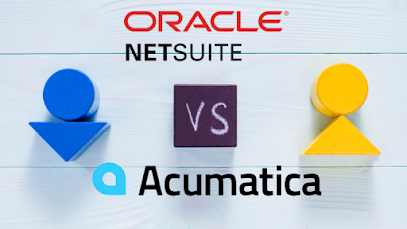Acumatica Pricing: A Transparent Look at the Costs
Learn about Acumatica pricing, including its modular design, licensing options, and consumption-based model. Discover how Acumatica’s flexible pricing benefits growing businesses.
Acumatica
pricing is designed with growing companies in mind, offering flexibility and
scalability that adapts to your business needs. Unlike many ERP solutions that
charge per user, Acumatica's cost is based on the computing resources and
applications your organization uses. This unique pricing model ensures you only
pay for what you need, making it a cost-effective choice for businesses of all
sizes. In this article, we’ll dive deep into how Acumatica pricing works and
what factors influence the overall cost.
Table of
Contents
- Introduction to Acumatica Pricing
- Key Elements of Acumatica’s
Pricing Structure
- Applications and Modules Pricing
- Software Licensing Options
- Transaction Volume-Based Pricing
- Real-World Pricing Insights
- Benefits of Acumatica's Flexible
Pricing Model
- How to Get a Customized Quote
- Conclusion
Introduction
to Acumatica Pricing
Acumatica
Cloud ERP is built for businesses seeking efficiency, growth, and
flexibility. Its innovative pricing structure moves away from the traditional
per-user model, instead focusing on the resources and functionalities a
business needs. This consumption-based approach makes it easier for businesses
to scale while keeping costs under control.
Key
Elements of Acumatica’s Pricing Structure
Acumatica
pricing is determined by three primary factors: the applications you choose,
your preferred licensing model, and your anticipated transaction volume. Let’s
break each element down.
1.
Applications and Modules Pricing
Acumatica’s
modular design allows businesses to select only the applications they need.
This ensures you’re not paying for features that don’t add value to your
operations.
For instance:
- A small business might start with
the Financial Management module to handle core accounting and
reporting functions.
- As the business grows, it could
add modules like CRM to manage customer relationships or Distribution
Management to handle inventory and supply chain operations.
- Larger organizations may expand
further with advanced modules such as Manufacturing Management or Project
Accounting.
The ability
to add modules as needed provides flexibility and scalability, ensuring your
ERP system evolves alongside your business.
2.
Software Licensing Options
Acumatica
offers three licensing models to suit varying business needs:
- SaaS Subscription: A cloud-based option with an
annual subscription fee. Installation and maintenance are managed by
Acumatica or a trusted hosting provider.
- Private Cloud Subscription: Offers the flexibility of
hosting the software on-premises or through a private cloud provider,
paired with an annual subscription fee.
- Private Perpetual License: A one-time-upfront payment for
the software, coupled with an annual maintenance fee. This traditional
model allows businesses to host the solution on-premises or with a hosting
provider of their choice.
Each
licensing model has its pros and cons, depending on your operational needs and
budget. An authorized Acumatica partner can guide you through these options to
determine the best fit for your business.
3.
Transaction Volume-Based Pricing
Unlike
traditional ERP systems that charge per user, Acumatica follows a
consumption-based pricing model. The cost is influenced by the transaction
volume and data storage your business requires.
This model
allows:
- Unlimited users, enabling
seamless collaboration across departments.
- Cost adjustments based on
business growth, ensuring you only pay for the resources you need at any
given time.
For example,
if you’re a growing SME, you can start with a lower transaction volume tier and
scale up as your business expands.
Real-World
Pricing Insights
While
Acumatica’s pricing isn’t publicly available, industry experts and ERP
consultants have provided ballpark estimates:
- SaaS Subscription: $30,000–$50,000 annually for a
system supporting 6–10 users, depending on the modules required.
- Private Perpetual License: Starts at $65,000 upfront, with
implementation costs ranging from $60,000 to $90,000 based on complexity
and integrations.
For
businesses seeking advanced features such as project accounting or CRM
integration, costs may increase. However, Acumatica remains competitive, often
more affordable than NetSuite while
offering robust functionality.
Benefits
of Acumatica's Flexible Pricing Model
- Scalability: Add or remove modules and
adjust transaction volume tiers as your business evolves.
- Cost Efficiency: Pay only for what you use,
avoiding unnecessary expenses.
- Unlimited Users: Enable collaboration without
incurring additional user license fees.
- Tailored Licensing: Choose a deployment model that
aligns with your operational needs and budget.
These
benefits make Acumatica an attractive choice for small to mid-sized enterprises
(SMEs) as well as larger organizations.
How to Get
a Customized Quote
To determine
the exact cost of Acumatica for your business, consult an authorized Acumatica
reseller. They will provide a tailored quote based on:
- The modules you need
- Your preferred licensing option
- Your projected transaction volume
Additionally, implementation, training, and consulting costs will vary based on the complexity of your requirements.
Conclusion
Acumatica’s
pricing model is designed with flexibility, scalability, and transparency in
mind. By focusing on applications, licensing preferences, and transaction
volumes, Acumatica ensures businesses only pay for what they need, making it a
cost-effective ERP solution for growing companies.
If you’re considering Acumatica, reach out to a certified partner to discuss your specific needs and obtain a customized quote. With its innovative pricing approach and robust features, Acumatica is well-positioned to support your business at every stage of growth.



Comments
Post a Comment